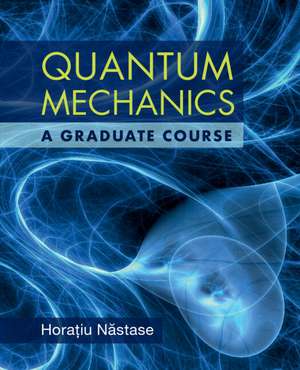Quantum Mechanics: A Graduate Course
Autor Horatiu Nastaseen Limba Engleză Hardback – 3 aug 2022
Preț: 540.09 lei
Preț vechi: 587.06 lei
-8% Nou
Puncte Express: 810
Preț estimativ în valută:
103.39€ • 106.33$ • 85.78£
103.39€ • 106.33$ • 85.78£
Carte disponibilă
Livrare economică 28 ianuarie-11 februarie
Livrare express 14-18 ianuarie pentru 70.67 lei
Preluare comenzi: 021 569.72.76
Specificații
ISBN-13: 9781108838733
ISBN-10: 1108838731
Pagini: 700
Dimensiuni: 210 x 261 x 40 mm
Greutate: 1.58 kg
Ediția:Nouă
Editura: Cambridge University Press
Colecția Cambridge University Press
Locul publicării:Cambridge, United Kingdom
ISBN-10: 1108838731
Pagini: 700
Dimensiuni: 210 x 261 x 40 mm
Greutate: 1.58 kg
Ediția:Nouă
Editura: Cambridge University Press
Colecția Cambridge University Press
Locul publicării:Cambridge, United Kingdom
Cuprins
1. The mathematics of Quantum Mechanics 1: Finite dimensional Hilbert spaces; 2. The mathematics of Quantum Mechanics 2: Infinite dimensional Hilbert spaces; 3. The postulates of Quantum Mechanics and the Schrödinger equation; 4. Two-level systems and spin 1/2, entanglement and computation; 5. Position and momentum and their bases, canonical quantization, and free particles; 6. The Heisenberg uncertainty principle and relations, and Gaussian wave packets; 7. One dimensional problems in a potential V (x); 8. The harmonic oscillator 9. The Heisenberg picture and general pictures; evolution operator; 10. The Feynman path integral and propagators; 11. The classical limit and Hamilton-Jacobi (the WKB method), Ehrenfest theorem; 12. Symmetries in quantum mechanics I: Continuous symmetries; 13. Symmetries in quantum mechanics II: Discrete symmetries and internal symmetries; 14. Theory of angular momentum I: operators, algebras, representations; 15. Theory of angular momentum II: addition of angular momenta and representations; oscillator model; 16. Applications of angular momentum theory: tensor operators, wave functions and the Schrödinger equation, free particles; 17. Spin and L + S; 18. The Hydrogen atom; 19. General central potential and 3 dimensional (isotropic) harmonic oscillator; 20. Systems of identical particles; 21. Application of identical particles: He atom (2-electron system) and H2 molecule; 22. Quantum mechanics interacting with classical electromagnetism; 23. Aharonov-Bohm effect and Berry phase in quantum mechanics; 24. Motion in a magnetic field, Hall effect and Landau levels; 25. The WKB and semiclassical approximation; 26. Bohr-Sommerfeld quantization; 27. Dirac quantization condition and magnetic monopole;s 28. Path integrals II: imaginary time and fermionic path integral; 29. General theory of quantization of classical mechanics and (Dirac) quantization of constrained systems; 30. Quantum entanglement and the EPR paradox; 31. The interpretation of quantum mechanics and Bell's inequalities; 32. Quantum statistical mechanics and tracing over a subspace; 33. Elements of quantum information and quantum computing; 34. Quantum complexity and quantum chaos; 35. Quantum decoherence and quantum thermalization; 36. Time-independent (stationary) perturbation theory: nondegenerate, degenerate, and formal cases; 37. Time dependent perturbation theory: first order; 38. Time-dependent perturbation theory: second and all orders; 39. Application: interaction with (classical) electromagnetic field, absorption, photoelectric and Zeeman effect; 40. WKB methods and extensions: state transitions and Euclidean path integrals (instantons); 41. Variational methods; 42. Atoms and molecules, orbitals and chemical bonds: Quantum chemistry; 43. Nuclear liquid droplet and shell models; 44. Interaction of atoms with electromagnetic radiation: transitions and lasers; 45. One-dimensional scattering, transfer and S matrices; 46. Three dimensional Lippmann-Schwinger equation, scattering amplitudes and cross-sections; 47. Born approximation and series, S- and T-matrix; 48. Partial wave expansion, phase shift method and scattering length; 49. Unitarity, optics and the optical theorem; 50. Low energy and bound states, analytical properties of scattering amplitudes; 51. Resonances and scattering, complex k and l; 52. The semiclassical: WKB and eikonal approximations for scattering; 53. Inelastic scattering; 54. The Dirac equation; 55. Multi-particle states in atoms and condensed matter: Schrödinger vs. occupation number; 56. Fock space calculation with field operators; 57. The Hartree-Fock approximation and other occupation number approximations; 58. Nonstandard statistics: anyons and nonabelions.
Descriere
A comprehensive, modern description of Quantum Mechanics at the graduate level, focused on developing the formalism and its applications.
